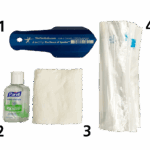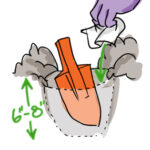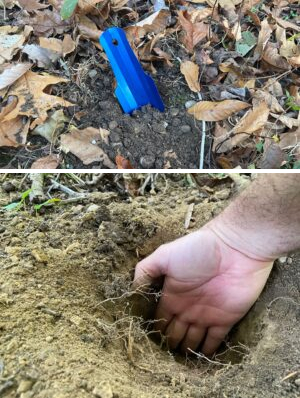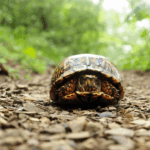What To Do When Nature Calls
There are usually only two options on the Trail: using a privy or digging a cat hole in the woods.
Privies (sometimes called outhouses or latrines) are small outbuildings near shelters and campsites that use different systems for containing and composting human waste. Cat holes are holes in the ground dug 4 to 6 inches wide and 6 to 8 inches deep where you poop and put your toilet paper.
Always Bring a Bathroom Kit
This is usually a gallon plastic bag with everything you need to successfully poop in the backcountry:
Come prepared with 1) a trowel, 2) hand soap or hand sanitizer, 3) toilet paper, and 4) plenty of disposable storage bags. This kit should come with you on every A.T. hike — from an afternoon stroll to a thru-hike.

Privies
If a privy is available, please use it. Privies concentrate waste in one area, which is especially helpful at popular overnight sites on the A.T. Privies work by composting human waste and most require some regular maintenance by volunteers. Properly using privies helps protect the surrounding environment, volunteers, and other hikers.
Most privies do not have toilet paper. You’ll need to bring your own.
Using a Privy
- Only poop and toilet paper can go in privies.
- Trash, tampons, pads, wipes (even “compostable” ones), socks, iPhones, etc. do not decompose in a privy. They must be packed out. And yes, we used real life examples!
- Food waste also should never be put in privies because it attracts wildlife. Pack it out.
- There are several kinds of privies on the A.T. that compost waste in different ways. Some you can pee in, others you can’t. Read and follow any instructions in the privy.
- Most privies require that you throw in a handful of duff (dead leaves and small twigs), wood shavings, or bark mulch after you’re done. This helps the decomposition process.
- Close and latch the door when you are done. This helps keep curious animals and flies out.
- Wash your hands with soap and water (best) or use hand sanitizer after you’re done.
- Do not touch any of the tools hanging on the back of the privy or nearby (shovels, pitchforks, etc.). These are most likely used to stir and manage raw sewage.

Cat Holes
Privies may not always be at hand when you need one on the Trail, and they might sometimes be closed by land managers for maintenance, repair, or closure orders. Sometimes the best course of action is to dispose of your poop in the woods using Leave No Trace principles by digging a cat hole; a small hole in the ground at least 6 inches deep that you poop in.
Key Cat Hole Info
- Cat holes should be dug at least 200 feet or 70 big steps away from trails, campsites/shelters, and water sources.
- Like privies, only poop and toilet paper should go in cat holes. Tampons, pads, socks, and wipes (even those labeled “compostable”) do not decompose in a cat hole. Pack it out.
- Never put food waste in a cat hole – this can attract wildlife. Pack it out, too.
- Be sure to dig a full 6-8 inches down and fully bury your poop.
- Putting a large rock or log over your poop does not actually bury it, and chances are someone else will come along and try to pick it up.
- Never “surface poop,” or leave poop uncovered or not in a deep enough hole. This is not only disgusting, but it’s a public health risk that can spread illness like norovirus.
- Cat holes should not be dug above treeline (in New England, where the trees are 8 feet or less in height at high elevations). The year-round cold weather and nutrient-deficient soil mean that your poop won’t decompose.
- Consider carrying an emergency WAG bag to pack out your poop in an above-treeline emergency, or in other places where it is impractical to dig a cat hole.

How to Dig a Proper Cat Hole
 Go before it’s an emergency. Digging a proper cat hole is much more difficult when the pressure is on.
Go before it’s an emergency. Digging a proper cat hole is much more difficult when the pressure is on.- Get off the Trail: Walk at least 200 feet from the Trail and stay 200 feet from water sources and campsites to prevent contamination. Don’t leave your food or gear unattended to answer nature’s call — bring everything with you.
- Dig a hole 6 to 8 inches deep and at least 5 inches wide and save the dirt you dig out. You can measure the depth of your cat hole using two methods:
- With your trowel: Many trowels have measurements on the side, while others are the same length as a properly dug cat hole.
- With your hand: A properly dug cat hole should be deep enough for your extended hand to fit in up to the wrist.
Pro tip: make sure to do this before completing step 4.
- Do your business. All poop and used toilet paper go in the cat hole. DO NOT bury wet wipes or feminine hygiene products, as they don’t decompose — carry them out in the spare storage bag.
- Fill it in. Refill your cat hole with soil and step on it to compact it a bit and make sure it stays covered. If you don’t feel comfortable stepping on your filled cat hole to pack it down, then it is not deep enough.
Peeing
Peeing on the A.T. is a bit more straightforward than pooping, but there are still some best practices to follow:
- Urinate away from trails, campsites, and water sources. While urine does not carry the same pathogens as poop, this helps keep areas clean and smelling clean. Some critters are also attracted to the salt in human pee.
- For those who squat to pee, a dedicated “pee rag” can help keep you clean and prevent chafing. And then you don’t have to pack out toilet paper. Your pee rag can be a bandana, small towel, or even a specially made cloth just for this purpose. Hang it on the back of your pack so it dries between uses.
- Pack out any used toilet paper or wipes. Toilet paper can also be buried in a 6- to 8-inch-deep cat hole.




